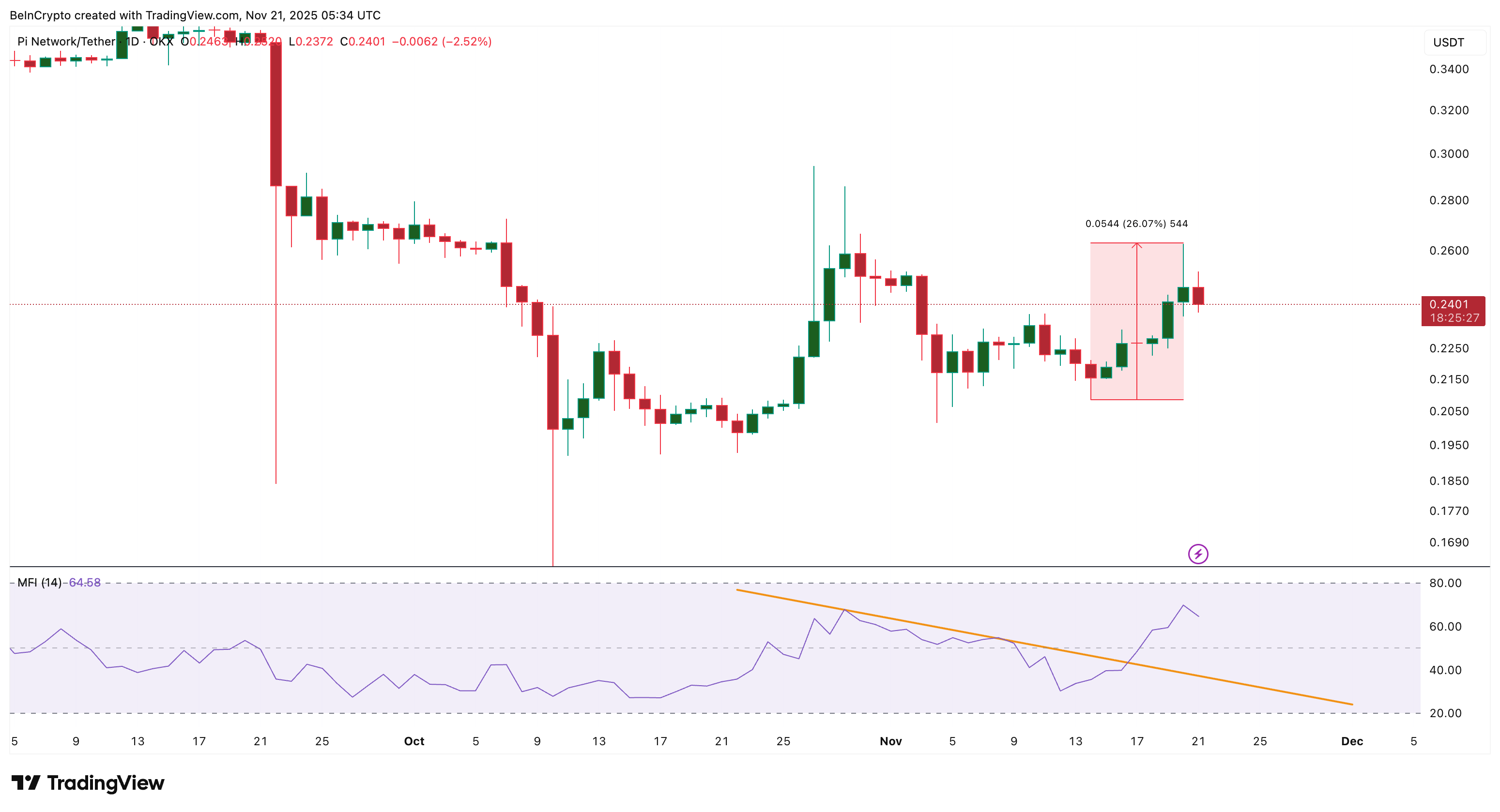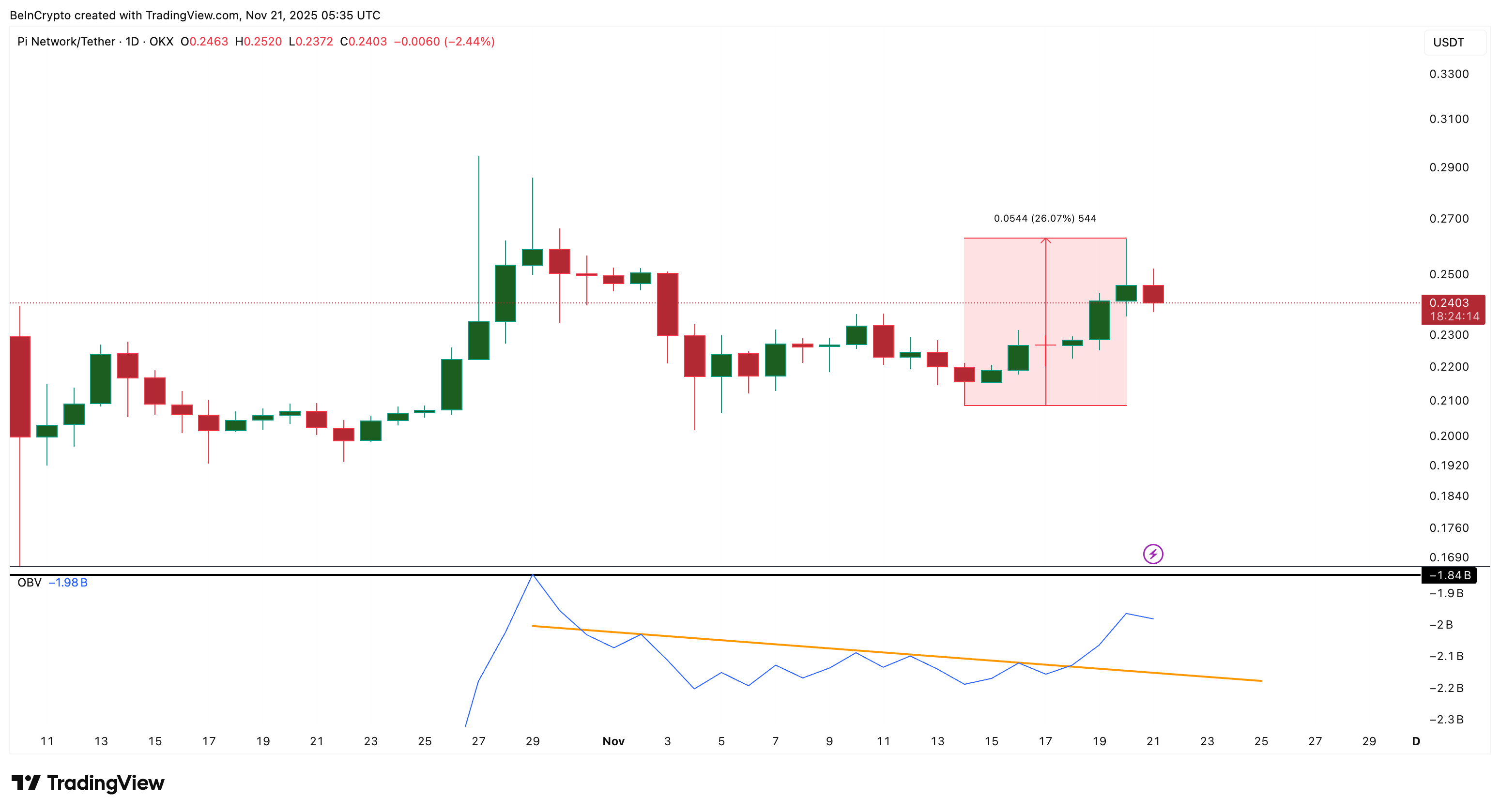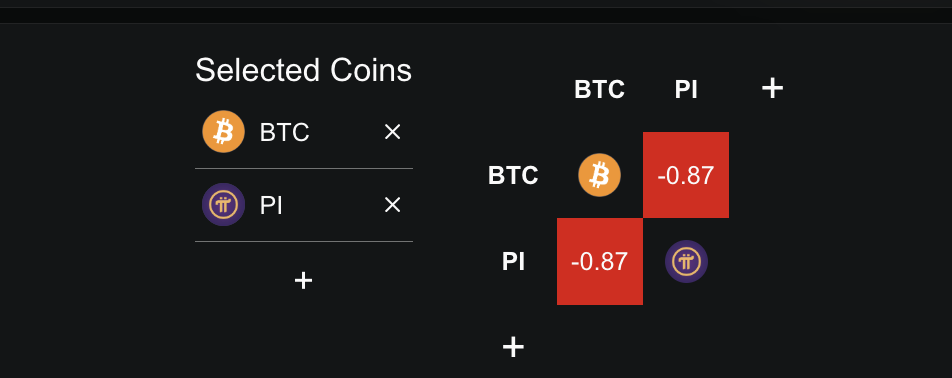Pi Coin Holds Gains in a Red Market — Another Breakout At 6.5%?
Pi Coin is one of the few assets holding green while much of the crypto market stays red this month. Bitcoin is down about 20% and Ethereum has dropped nearly 27% month-on-month. Pi Coin price, once seen as a weaker project, is still up almost 18% in the same period. Even after today’s 5% dip,
Pi Coin is one of the few assets holding green while much of the crypto market stays red this month. Bitcoin is down about 20% and Ethereum has dropped nearly 27% month-on-month. Pi Coin price, once seen as a weaker project, is still up almost 18% in the same period.
Even after today’s 5% dip, its monthly trend remains positive. This unusual strength now puts Pi Coin (PI) only 6.5% away from a fresh breakout attempt. Here’s how!
Money Flow Strengthens The Uptrend
The first sign of strength comes from the Money Flow Index (MFI). MFI uses both price and volume to show if buyers or sellers are in control. Pi Coin broke above its MFI trend line on November 16, right as the price started rising.
Since November 14, Pi Coin has climbed almost 26%, and the MFI breakout confirmed that buyers were active early. The indicator has pulled back slightly, but it is still above its trend line. As long as it stays above it, dips are more likely to act as simple pullbacks instead of full reversals.
 Dip Buying Continues:
Dip Buying Continues:
Want more token insights like this? Sign up for Editor Harsh Notariya’s Daily Crypto Newsletter here.
Volume flow supports this idea as well. The On-Balance Volume line (OBV) broke its trend line on November 18, two days after the MFI breakout. OBV tracks whether more volume is flowing into the asset or out of it.
A late OBV breakout usually means smaller traders joined after larger wallets took the first step. OBV is still in negative territory near –1.84 billion, a common feature of downtrends. Do note that the PI price trend still points down in the long term, as it’s down by over 30% in the last three months.
 Volume Backs The PI Story:
Volume Backs The PI Story:
The upward OBV slope shows improving demand. Clearing –1.84 billion would strengthen the short-term trend.
A rare detail adds more weight: PI’s seven-day correlation with Bitcoin sits near –0.87. This is the Pearson coefficient, which measures whether two assets move together. A reading close to –1 means they move in opposite directions.
 PI-BTC Correlation:
PI-BTC Correlation:
That explains why Pi Coin has remained green while Bitcoin and other large caps fell. If BTC continues to correct, the Pi Coin price might see more upside, per this theory.
An Upcoming Crossover Builds a Bullish Case
The 4-hour chart adds to the bullish argument. Pi Coin trades above all major exponential moving averages. The 50-period average is moving closer to the 200-period average.
 Pi Coin Could Extend Gains In The Short-Term:
Pi Coin Could Extend Gains In The Short-Term:
If the 50 crosses above the 200, the structure forms what traders call a golden crossover. It usually means short-term strength is catching up to long-term trend direction. This setup supports the idea that Pi Coin’s uptrend still has room.
Exponential moving average (EMA) gives more weight to recent price data, so it reacts faster than simple moving averages.
Pi Coin Price Levels to Watch
Trend-based Fibonacci extensions show the next resistance near $0.25. Pi Coin needs a clean daily close above this level to unlock the next wave higher. That requires a move of roughly 6.5% from the current price. Crossing $0.25 might allow Pi Coin’s rally to extend higher, with even $0.31 and $0.34 in contention.
On the downside, the key support sits near $0.23. Losing it on a daily close increases the risk of a drop toward $0.20, which would wipe out most of Pi Coin’s recent gains.
 Pi Coin Price Analysis:
Pi Coin Price Analysis:
For now, Pi Coin remains one of the rare green assets in a red market, on a monthly timeframe. If buyers can push it 6.5% higher, another breakout attempt may be just ahead.
Disclaimer: The content of this article solely reflects the author's opinion and does not represent the platform in any capacity. This article is not intended to serve as a reference for making investment decisions.
You may also like
TWT's Updated Tokenomics Framework: Key Changes and Market Impact for 2025
- TWT faces potential tokenomics shifts in 2025, inferred from industry trends toward buybacks and utility diversification. - Projects like Treehouse DAO and XRP Tundra highlight growing emphasis on deflationary mechanics and transactional utility. - TWT's long-term success depends on aligning with these trends through governance upgrades or cross-chain integration. - Investor sentiment remains cautious due to lack of official TWT announcements, despite broader market demand for sustainable token models.

Bitcoin Updates: Bitcoin ETF Withdrawals Underscore Rising Altcoin Momentum Amid Changing Crypto Focus
- BlackRock's IBIT Bitcoin ETF saw $3.79B in November outflows, marking its worst month since launch amid Bitcoin's 13% weekly price drop below $80,000. - Analysts link redemptions to profit-taking after October's $126,000 peak and macro concerns like delayed Fed rate cuts, creating a self-reinforcing price decline cycle. - Institutional buyers see Bitcoin's $90,000 level as a buying opportunity, while altcoin ETFs like Solana's BSOL attract $660M inflows with competitive staking yields. - Citigroup warns

Bitcoin News Today: Bitcoin Faces $80K Turning Point: Will a Short Squeeze Ignite or Is a Further Decline Ahead?
- Bitcoin fell below $80,000 in November 2025, triggering debates over short-squeeze rebounds vs. deeper bear markets amid macroeconomic fears and ETF outflows. - A "death cross" technical signal and $800M in on-chain losses highlight market fragility, with $1T wiped from crypto since October. - Analysts remain divided: bullish targets ($200K) clash with bearish warnings of $74,500 retests, while institutions like Harvard buy dips. - Negative funding rates suggest short-covering potential, but $20B in liqu
Astar 2.0: Transforming Blockchain Scalability and Pioneering DeFi Advancements
- Astar 2.0 tackles blockchain scalability via ZK Rollups, zkEVM, and LayerZero interoperability, enabling cross-chain liquidity and Ethereum compatibility. - Hybrid AMM-CEX models reduce slippage while AI-powered security attracts institutions, with TVL reaching $1.4B and 20% QoQ institutional wallet growth. - Tokenomics 3.0 caps ASTR supply at 10.5B tokens, paired with Burndrop PoC to create scarcity, while governance shifts to community councils by mid-2026. - Startale App (2026) and Polkadot Plaza inte

